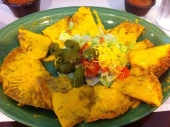A few days ago, I posted about
heuristic cooking -- a term I'm coining for following procedures that are much looser than what I think of as a traditional recipe. And last summer I posted a draft heuristic salsa recipe in
another thread here about salsa. So I'm back to pad that out into a framework that anyone can follow, provide examples, and invite you all to try it out and post the results.
How to make salsa
Gather some stuff that would be good in a salsa, char some of it, break it down, and combine it.
A) A set of good salsa ingredients probably includes: chiles (fresh or dried or both), onion, cumin, and either tomato or tomatillo. It might also have some of: garlic, cilantro, corn, beans, or lime juice. And when you want to play, maybe include one or more of these: pineapple, pepitas, peaches, other fruit, veggies, nuts, avocado, herbs and spices. Sometimes it's down to what you have a lot of. If you replace the tomato element with zucchini and a little broth, it still works.
B) You probably want to blacken some of it — on a grill, cast iron pan, or under the broiler. Maybe you blacken the garlic in a cast-iron pan so that peeling the charred skins is easier while roasting the tomatoes under the broiler. Maybe you cycle everything over a wood fire -- the grill marks aren't going to matter, but the smokey infusion certainly does! I don't blacken fresh herbs, but I tend to get some char on lots of structural elements.
C) You can like it chunky or smooth, but it isn't really salsa unless you break the elements down. To be traditional, use a basalt
molcajete (though I suggest cutting onions up small first). But you're more likely to have a blender or food processer. Those work fine but run the risk of over-blending (unless that's what you want!). My favorite tool for this is a food-grinder attachment for our stand-mixer -- it makes just the right texture when using the widest die. But also, you can just use a knife and cutting board! There really isn't a wrong option. Some of the ingredients you won't want to blend -- corn and beans, for instance just get stirred in when this step is done.
D) You're so close. Maybe you're done. But taste it. This is when you hit it with a little salt and/or sugar if needed, but feel free to skip when it isn't.
I think you can see how this will make a million different salsas, all following the same heuristic.
I've made dozens of excellent salsas using this process and only one bad (I included just an absolute crapload of basil, including too much stem-fiber that didn't get mashed up enough. The chewy strands of fiber were unappealing.)
I'd love to see what any of you make by following this process.








